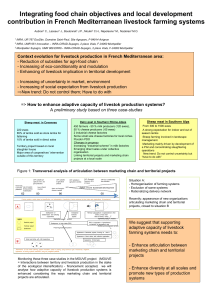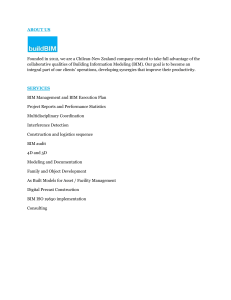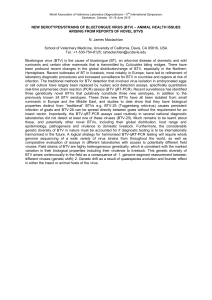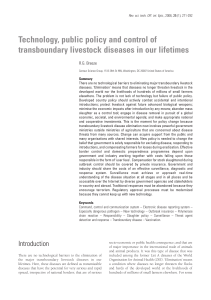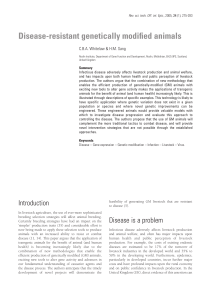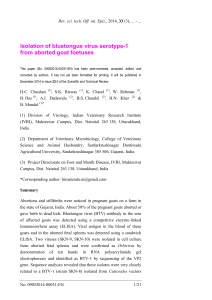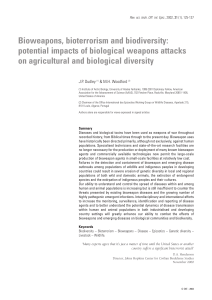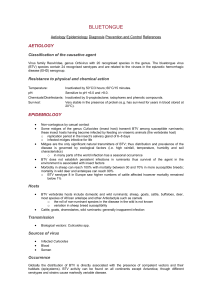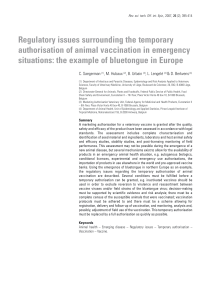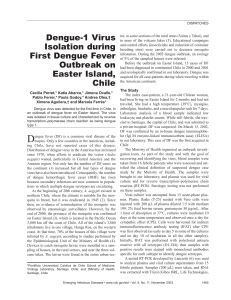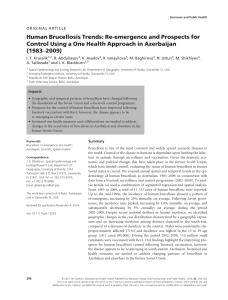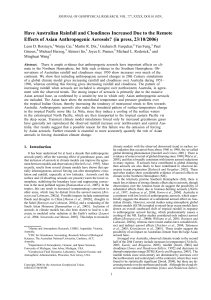D5489.PDF
publicité
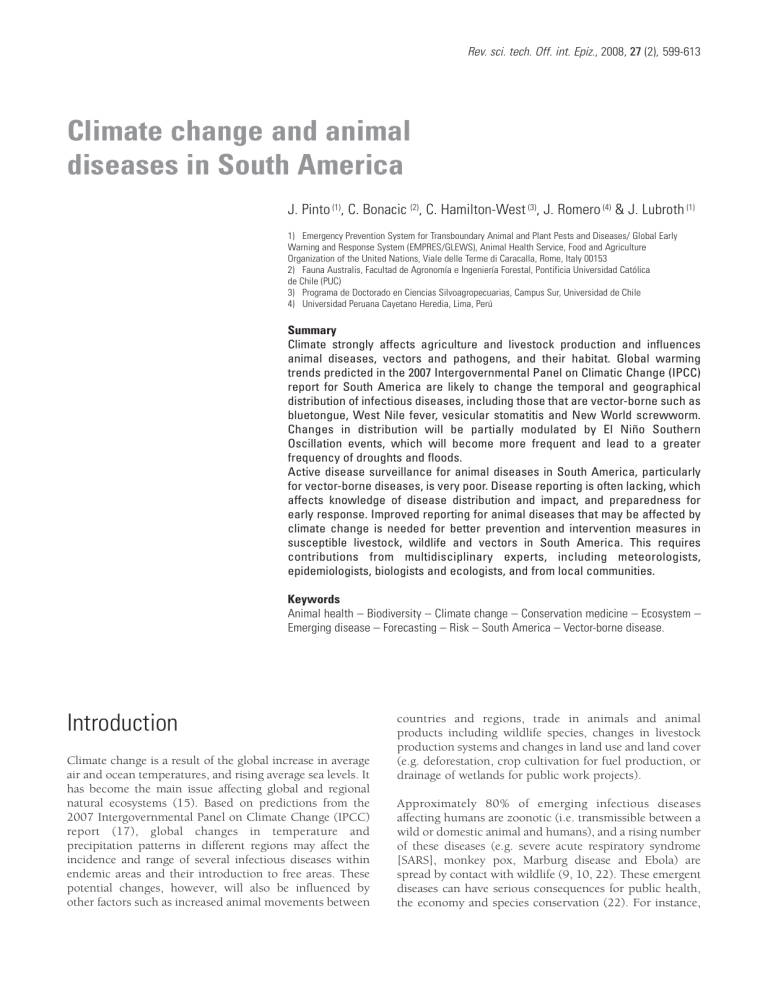
Rev. sci. tech. Off. int. Epiz., 2008, 27 (2), 599-613 Climate change and animal diseases in South America J. Pinto (1), C. Bonacic (2), C. Hamilton-West (3), J. Romero (4) & J. Lubroth (1) 1) Emergency Prevention System for Transboundary Animal and Plant Pests and Diseases/ Global Early Warning and Response System (EMPRES/GLEWS), Animal Health Service, Food and Agriculture Organization of the United Nations, Viale delle Terme di Caracalla, Rome, Italy 00153 2) Fauna Australis, Facultad de Agronomía e Ingeniería Forestal, Pontificia Universidad Católica de Chile (PUC) 3) Programa de Doctorado en Ciencias Silvoagropecuarias, Campus Sur, Universidad de Chile 4) Universidad Peruana Cayetano Heredia, Lima, Perú Summary Climate strongly affects agriculture and livestock production and influences animal diseases, vectors and pathogens, and their habitat. Global warming trends predicted in the 2007 Intergovernmental Panel on Climatic Change (IPCC) report for South America are likely to change the temporal and geographical distribution of infectious diseases, including those that are vector-borne such as bluetongue, West Nile fever, vesicular stomatitis and New World screwworm. Changes in distribution will be partially modulated by El Niño Southern Oscillation events, which will become more frequent and lead to a greater frequency of droughts and floods. Active disease surveillance for animal diseases in South America, particularly for vector-borne diseases, is very poor. Disease reporting is often lacking, which affects knowledge of disease distribution and impact, and preparedness for early response. Improved reporting for animal diseases that may be affected by climate change is needed for better prevention and intervention measures in susceptible livestock, wildlife and vectors in South America. This requires contributions from multidisciplinary experts, including meteorologists, epidemiologists, biologists and ecologists, and from local communities. Keywords Animal health – Biodiversity – Climate change – Conservation medicine – Ecosystem – Emerging disease – Forecasting – Risk – South America – Vector-borne disease. Introduction Climate change is a result of the global increase in average air and ocean temperatures, and rising average sea levels. It has become the main issue affecting global and regional natural ecosystems (15). Based on predictions from the 2007 Intergovernmental Panel on Climate Change (IPCC) report (17), global changes in temperature and precipitation patterns in different regions may affect the incidence and range of several infectious diseases within endemic areas and their introduction to free areas. These potential changes, however, will also be influenced by other factors such as increased animal movements between countries and regions, trade in animals and animal products including wildlife species, changes in livestock production systems and changes in land use and land cover (e.g. deforestation, crop cultivation for fuel production, or drainage of wetlands for public work projects). Approximately 80% of emerging infectious diseases affecting humans are zoonotic (i.e. transmissible between a wild or domestic animal and humans), and a rising number of these diseases (e.g. severe acute respiratory syndrome [SARS], monkey pox, Marburg disease and Ebola) are spread by contact with wildlife (9, 10, 22). These emergent diseases can have serious consequences for public health, the economy and species conservation (22). For instance, 600 SARS alone has killed over 700 people and has cost the global economy US$ 50 billion. When such diseases appear and spread unabated, confidence in the structures of a civil society designed to protect life and conserve natural resources is eroded. Because arthropods are highly sensitive to environmental and seasonal temperatures, the range of vector-borne diseases such as bluetongue, West Nile fever, Venezuelan equine encephalitis, Rift Valley fever, African horse sickness (AHS) and visceral leishmaniasis may be limited by the distribution of competent vectors. Some of these vector-borne diseases have been reported in areas of South America, others are still absent from the continent (highlighting the importance of specific early detection and warning mechanisms) and others may change in occurrence and intensity. For instance, the expansion of the geographical range of Anopheles vectors and the lack of well structured and financed public health systems could explain the re-emergence of malaria and dengue in South America, central Africa and Asia during the 1980s and 1990s (9, 10). Similarly, some species of biting midge known to be vectors for AHS and bluetongue have recently invaded Europe and North Africa (34). There is a global trend for mosquitoes and biting midges to populate and establish themselves in new ecosystems. Although there are several historical records of bluetongue outbreaks in Europe, the recurrent exotic introductions since 1998 have been alarming, with six strains of bluetongue virus identified across 12 countries and occurring some 800 km further north than ever previously reported (14). This rapid spread has been driven by climate change, which has increased virus persistence in vector hosts during the winter period and the northward expansion of Culicoides imicola, an indigenous European midge species, thereby expanding the risk of transmission over larger geographical regions (34). In addition, animal parasites, including tickborne diseases in Africa and the New World screwworm (Cochliomyia hominivorax) in South America, have spread to new regions, causing a negative impact on livestock production and causing direct or indirect effects on public health (35). This article describes the situation with respect to animal diseases in South America that could be affected in their spatial and temporal distribution by increases in ambient and oceanic temperatures. The effects of climate change on selected diseases are based on forecast models described in the IPCC report (17). Overall, it is anticipated that such pathogens will increase, the risk of their re-emergence and spread will grow, and more pathogens of importance to the animal/human interface will become commonplace. Lastly, this overview proposes some general recommendations to Veterinary Services and public health authorities to face and address prevention, detection and control of animal diseases in a rapidly changing environment. Rev. sci. tech. Off. int. Epiz., 27 (2) Climates of South America A wide variety of climates, soil types, and ecological environments occur in South America (Fig. 1). From steaming tropical rain forests to arid, desert-like coasts, from snow-covered jagged peaks in the Earth’s longest mountain chain down to glaciers at sea level, a great variety of climates can be found in this region, which covers 13% of the world’s area (43). Climates range from the dry desert conditions of northern Chile and the coastal region of Peru to neo-tropical rain forests, river flood plains, and the heavy precipitation-prone areas along the south-western coast of the continent. In general, most of the continent is mildly temperate with humid tropical river basins (49). The South American land mass extends over 3,000 km further south than the southern tip of Africa, at a latitude of 56° S, versus 35°. Four areas in South America have climates characterised by a lack of rainfall. The two main desert areas are along the west coast of the continent and in Argentina. Much smaller arid areas are found in north-eastern Brazil and along the coast of Venezuela. The entire coastal area of Peru and the northern part of Chile is one of the driest regions of the Climates Warm tropics Cool tropics Cold tropics Warm sub-tropics (summer rainfall) Cool sub-tropics (summer rainfall) Cold sub-tropics (summer rainfall) Cool sub-tropics (winter rainfall) Cold sub-tropics (winter rainfall) Cool temperature Cold temperature Transitional Moderately cool tropics Warm moderately cool sub-tropics (summer rainfall) Warm moderately cool sub-tropics (summer rainfall) Fig. 1 Climates in South America (50) 601 Rev. sci. tech. Off. int. Epiz., 27 (2) Earth (45). Semi-arid climates generally receive low annual rainfall (250 mm to 500 mm). Wet–dry tropical climates (savannah) result from seasonal changes between wet tropical air masses and dry tropical air masses and show alternation of a very wet and a very dry season (50). The highland climates are cool to cold and are found in mountains and high plateaus, with wet and dry periods and temperature ranges between −18°C and 10°C (50). Most of the Orinoco Basin and virtually all of the Amazon Basin, as well as the lower parts of the Guiana Highlands and the eastern foothills of much of the Andes, have a climate characterised by continuous high temperatures and heavy rainfall. There is little seasonal variation in temperatures because this zone lies along the equator (45). Rain forests belong to the tropical wet climate group, with temperatures rarely higher than 34°C or lower than 20°C, and average humidity ranges between 77% and 88%. There is usually a brief season of lower rainfall. Almost all rainforests lie within the equatorial region (49). The subtropical dry climate is a humid climate characterised by hot, humid summers and chilly to mild winters. This climate type covers a broad category of environments, and the term ‘subtropical’ may be a misnomer for the winter climate in the cooler areas within this category. Significant amounts of precipitation occur in all seasons in most areas. Winter rainfall (and sometimes snowfall) is associated with large storms that the westerly winds steer from west to east. Most summer rainfall occurs during thunderstorms and an occasional tropical storm. Humid subtropical climates lie on the south-eastern side of all continents except Antarctica, roughly between latitudes 25° N and 40° S (45, 50). Average annual temperatures of less than 10°C are found in the southernmost parts of Argentina and Chile and at high elevations throughout the Andes. A damp, cold climate characterises the Tierra del Fuego region. Constant high winds make the southern tip of the continent an unattractive place for human settlement. Humid oceanic climates are found only on the western side of the continent where prevailing winds blow from sea to land. The moderating influence of the ocean reduces the seasonal temperature contrast so that winters are cool to mild and summers are warm. Moderate precipitation occurs throughout the year. Low clouds, fog, and drizzle are common (50). The subtropical region is essentially a large plain (Gran Chaco and the Pampa) which rises gradually from east to west (43). The hottest weather in South America occurs in the region of Chaco (where the corners of Paraguay, Bolivia and Argentina meet); here the temperature can approach 43°C. Temperatures in the Amazon region generally range from 21°C to 32°C and rarely reach 38°C. South of the equator, summer lasts from late December to late March and winter runs from late June to late September (45, 50). Most of South America receives ample rain. Rainfall averages more than 2,000 mm a year in some areas, including coastal French Guiana, Guyana, Suriname, the Amazon River Basin, south-western Chile, and the coasts of Colombia and northern Ecuador. In south-western Chile, humid westerly winds blow in from the Pacific and drop most of their moisture as rain before crossing the Andes. As a result, the area east of the Andes is very dry. For example, the Patagonia region in south-eastern Argentina and parts of Chile receive only about 250 mm of rain each year on average (45). The dry conditions of coastal Peru and northern Chile result from the cold Peru Current, which flows northwards just off the coast. At irregular periods, usually every two to seven years, the northward Peru Current weakens and stronger warm waters flow southwards along the coast (25). This event is called El Niño (‘The Child’ in Spanish) or ENSO (El Niño Southern Oscillation) because of its occurrence in late December, over the Christmas season. The ENSO is the most well known phenomenon influencing global climate variability on inter-annual time scales, and the term refers to the large-scale oceanatmosphere climate phenomena linked to periodic warming in sea surface temperatures across the central and east-central equatorial Pacific (2). The ENSO drives climatic variability in South America and causes large socio-economic impacts in the areas when it occurs (17). Climate change in South America Climate change encompasses several effects in the Latin American and Caribbean region, including coastal erosion and increased sea levels. There is controversy among scientists regarding the association of climatic change and hurricane frequency caused by ocean warming, particularly in the Caribbean (15). These natural disasters affect the economy, livestock production and livelihoods, and increase risks of disease for both humans and livestock and the spread of wind-blown pests or vectors to distant lands. Despite the global impact of deforestation of the Amazon, its immediate effect in Latin America is through a reduction of evapo-transpiration from plants and a decrease of precipitation, causing increased arid biomass. Large sections of the Colombian and Brazilian Amazon forest have been cleared for agriculture or pasture (13, 44). However, not all outcomes are related to dry conditions – there have been several natural phenomena in recent years that are now believed to be related to climate change, such as the intense rainfall in Venezuela in 1999 and 2005, and flooding of the Argentinean pampas (2000 to 2002) and Buenos Aires 602 Rev. sci. tech. Off. int. Epiz., 27 (2) (2006). Increases in rainfall in some areas of Brazil, Paraguay, Uruguay and Argentina have increased the intensity and frequency of floods. On the other hand, decreases in rainfall in the south of Chile, south-west of Argentina and southern Peru have contributed to shortages of water. The projected mean warming in South America to the end of this century will range from 1°C to 4°C (17). This potential change would affect biodiversity by increasing the risk of species extinctions via replacement of tropical forest by savannas in the eastern Amazonian region, causing changes in arthropod vector habitat (17, 40). The ENSO events have been associated with severe floods, droughts and landslides. They have also had direct effects on human health: ENSO has been associated with an DJF JJA Number of models > 0 Precipitation response (%) Temperature response (°C) Annual increased risk of malaria in coastal regions of Colombia and Venezuela (33) and outbreaks of hantavirus pulmonary syndrome reported in Argentina, Bolivia, Chile, Paraguay and Brazil after periods of prolonged drought (49). Some epidemiological models have projected a substantial increase in the risk of malaria in coastal Peru, Ecuador and Venezuela because of the increased Anopheles vector populations that will develop when various types of immature habitat are flooded after heavy rainfall following a period of drought (2). Other diseases such as visceral leishmaniasis (8) and leptospirosis (18) have been associated with periods of drought and flooding, respectively. Drought conditions leading to increased dengue fever were observed in areas of the north-eastern States of Brazil (2). Fig. 2 Temperature and precipitation changes over Central and South America from the MMD-A1B simulations Top row: annual mean, DJF (December, January and February) and JJA (June, July and August) temperature change between 1980-1999 and 20802099, averaged over 21 models Middle row: same as top, but for fractional change in precipitation Bottom row: number of models out of 21 that project increases in precipitation (17) 603 Rev. sci. tech. Off. int. Epiz., 27 (2) By 2020, temperatures in South America have been forecasted to change in the range of 0.4°C to 1.8°C and by 2080 between 1.0°C and 7.5°C (17). For precipitation, projections indicate a much higher degree of uncertainty for tropical regions in South America; however, the frequency of the occurrence of extreme climate events such as ENSO is likely to increase in the future. Precipitation is likely to increase in Tierra del Fuego during winter and in south-eastern South America during summer; however, it is not known how annual and seasonal mean rainfall will change in northern South America, including the Amazon Forest (17). For South America, the multi-model mean precipitation response (Fig. 2) indicates marked regional variation. The annual mean precipitation is projected to decrease in northern South America near the Caribbean coasts, and in large parts of Brazil, Chile and Patagonia, and to increase in Colombia, Ecuador and Peru, around the equator and in south-eastern South America. All of Central and South America is very likely to become warmer during this century. The annual mean warming is likely to be similar to the global mean warming in southern South America but larger than the global mean warming for the rest of the area (17). Finally, the main anticipated impacts of climate change in South America described in the 2007 IPCC report are (17, 24): – by 2050, increases in temperature and associated decreases in soil water are projected to lead to gradual replacement of tropical forest by savannah in the eastern Amazonian region – in drier areas, climate change is expected to lead to salinisation and desertification of agricultural land and a decline in livestock productivity – changes in precipitation patterns and the disappearance of glaciers are projected to significantly affect water availability for human consumption, agriculture and energy generation – emerging diseases, including food-borne and vectorborne diseases, are projected to increase and have an impact on human and animal health. Livestock production systems and climate change Controversy exists about livestock production and its effect on climate change. It is estimated that livestock occupies 30% of world land area (through direct pasture grazing and land for feed crops) and is a significant source of landbased pollution and gas production (methane, carbon dioxide and phosphorous oxide). Land usage and deforestation of jungle to establish cattle enterprises are widely recognised (44). Livestock production is very important in South America; the region supports 25% of the world population of cattle, 12% of the world’s poultry population, 9% of sheep and 6% of pigs (44). Natural and crop pasture grazing systems are predominant in cattle production. Pasture availability depends on rainfall and temperature. For instance, during and after ENSO events, problems with pasture supply have affected cattle production systems in Colombia, where farmers faced great difficulties with extended dry periods and crop availability leading to increased disease risk, toxic plant ingestion, animal movements, weight loss, general debilitation and death (28). Despite lack of thorough regional epidemiological data that document the effect of ENSO on specific animal diseases and livestock production, the effect that nutrition deficiencies and temperature changes have on reproductive performance and disease susceptibility is widely recognised. Economic losses as a result of low reproductive rates have been reported in tropical conditions in Latin America (42). In addition, pastoralist and free-range production systems used for cattle, small ruminants and pigs are greatly affected by low availability of pasture and forage under current production systems, both on commercial and smallholder farms. Because of the ENSO, both dry seasons and floods are catastrophic to livestock production systems highly dependent on the pasture feed supply (43). Moreover, the irregular availability of, or unpredictable effects on, crops and grains will undoubtedly affect prices of inputs to the animal feed industries as well as changing the land use structure of mixed farming systems. Unfortunately, there is a lack of data and scientific literature available to appraise this, but consistent news reports document such effects. The National Drought Mitigation Center of Nebraska University in the USA summarised the impacts of the ENSO during 1997 to 1998; they included drought and animal feed shortages in Panama, Colombia and some parts of Brazil, and floods, animal deaths and ruined harvests in Chile, Peru, Ecuador, Uruguay, Argentina and southern Brazil. Moreover, crop damage and lower production yields of corn, sorghum and soybean harvests were documented in the Dominican Republic, Honduras, El Salvador, Guatemala, Nicaragua, Ecuador and Brazil (31). Animal diseases and climate There is a large body of scientific literature on the effect of climate change on the incidence of human diseases transmitted by arthropod vectors (47). However, specific studies describing the impact of environmental change on livestock and wildlife diseases or pathogen emergence are not abundant, especially in a South American context. Factors such as landscape changes that remove portions of 604 Rev. sci. tech. Off. int. Epiz., 27 (2) host populations (e.g. habitat alteration or destruction), alteration of host migration patterns (e.g. habitat fragmentation) or increased host density that are likely to influence disease emergence have been described, however (9, 10). South America, with infestations increasing in spring and summer and decreasing in autumn and winter (23). On the other hand, leishmaniasis in humans has been associated with the increased frequency of drought as this facilitates reproduction and growth of adult sand flies (7). The geographical distribution of vector-borne diseases is influenced by the geographical distribution of both vertebrate host (where one exists) and the distribution of the vector (16); other contagious diseases are also subject to a degree of environmental influence, including parasite life cycles and animal infectious diseases such as foot and mouth disease (FMD) or anthrax, which can be transmitted by wind-borne aerosol spread (3). Human diseases such as cryptosporidiosis, haemorrhagic fevers, cholera and malaria have been associated with flooding caused by ENSO events (10). Increased precipitation may also cause changes in the prevalence and intensity of parasite infestations, increasing host mortality in wild and domestic species (11). In order to soundly assess the impact of climate change as it is predicted for South America by the IPCC report on the epidemiology of emergent zoonotic diseases (17), it is important to highlight the lack of scientific research and knowledge available in countries of the region. Although other regions of the world present a significant body of work on some vector-borne diseases such as bluetongue in Europe, Rift Valley fever in Africa and West Nile virus in the USA (10, 33), such studies have not been conducted in South America. As a consequence of this lack of investment into the required field or modelling research, it is difficult to make a robust assessment of the impact of climate change on animal infectious diseases in South America. For contagious animal diseases where close contact between animals is the main mechanism for disease transmission, climate change is expected to have a minor impact on spread. However, climate events such as prolonged drought could change livestock production dynamics and lead to aggregation of animals in areas where water and pastures are available. In transhumant production systems, or areas where livestock is kept close to wildlife reserves, the rate of contact between species, and therefore the risk of spread of diseases between herds or between livestock and wildlife, would be expected to increase. In addition, the more contact between wildlife populations and domestic species the higher the likelihood of exposure to novel pathogens, leading to emergence of new diseases in humans and animals (4, 5). In Chile, for example, neutralising antibodies against parainfluenza PI-3, a virus which is relatively common in cattle, have been found in Huemul deer (Hippocamelus bisulcus) in Aysen, Chile – a species which is in danger of extinction (29). For contagious animal diseases, climate may be associated with seasonal occurrence of diseases rather than with spatial propagation (3). This is the case for pathogens or parasitic diseases, such as fascioliasis, in areas with higher temperatures, when seasonality is extended as a consequence of the increased survival of the parasite outside the host or, conversely, shortened by increased summer dryness that decreases their numbers (3). For other pathogens, such as parasites that spend part of their life cycle as free stages outside the host, temperature and humidity may affect the duration of survival (23). Climate change could modify the rate of development of parasites, increasing in some cases the number of generations and then extending the temporal and geographical distribution. New World screwworm is frequently found in An example of an animal disease that could be altered in its distribution in time and space is New World screwworm (Cochliomyia hominivorax), which is already widely distributed in South America; however, there remain some areas where the fly cannot survive (Table I). The historical and current distribution of the fly lies from the southern part of the USA and Mexico, to tropical and subtropical regions of Central America, Panama and countries of the north-east of South America, to Uruguay and parts of Argentina (23, 38). In Brazil, a strong association has been demonstrated between the level of precipitation, the temperature and the spread of screwworm (23). There is also seasonal variation in the prevalence of animals infested with screwworm larvae in some areas of Brazil, with the highest rate occurring in the summer followed by spring, winter and autumn (23). Table I New World screwworm in South America, 2004 to 2006 (52) Country OIE status 2004-2006 Argentina Demonstrated clinical disease Bolivia Disease absent Brazil Demonstrated clinical disease Chile Disease never occurred Colombia Disease absent Ecuador* Demonstrated clinical disease French Guiana Disease absent Guyana Demonstrated clinical disease Paraguay Demonstrated clinical disease Peru Unknown Suriname Unknown Uruguay Demonstrated clinical disease Venezuela Unknown *Disease restricted to certain zone(s) / region(s) of the country 605 Rev. sci. tech. Off. int. Epiz., 27 (2) Elimination of a disease or a vector from a geographical area protects the wildlife in the area that is susceptible to the disease. The use of techniques such as the sterile insect technique (SIT) has been very useful in the eradication of screwworm from some areas of Central and South America (37). West Nile fever is a zoonotic vector-borne disease that was detected for the first time in the western hemisphere in New York in 1999, and subsequently spread throughout the USA to Central America and parts of South America. The status of the disease in some countries of South America remains uncertain because animal disease surveillance systems and vector surveillance are deficient in most of the countries (35). Figure 3 shows the status of West Nile virus (WNV) in South America as reported to the World Organisation for Animal Health (OIE). The occurrence and spread of WNV disease in the Americas in 1999 triggered the inclusion of WNV in the OIE list of animal diseases in 2006. Wild birds are known to be reservoirs for several pathogens, including WNV, and serve as amplifying hosts for the virus in nature (36). In the USA, WNV spread from New York to the north and south with the movement of migratory birds (35). The migration of birds is driven in part by seasonal climatic factors, and any change in climatic conditions may modify the direction and intensity of spread of diseases. Similar disease ecology and wildlife interactions of pathogens associated with wild birds have been observed for Newcastle disease (19), WNV (6, 32) and influenza A viruses (36). The mosquitoes Culex spp. are the main vectors of WNV and, specifically in the USA, Culex pipiens and Culex restuans play an important role as vectors, as they do for the taxonomically related St Louis encephalitis virus. In South America, mosquitoes belonging to the genus Culex could play an important role in the transmission of WNV (35). Susceptible species including horses and birds have been reported to be affected by WNV in some Caribbean islands, Mexico and northern Central America; horses are considered as dead end or incidental hosts for this virus (26). The first serological evidence of the presence of WNV infection in South America was described in the Colombian Departments of Sucre and Córdoba in the Caribbean region in 2004 (20, 26) (Table II). In late February and March 2006, three horses died in the city of Buenos Aires, where WNV was diagnosed (30). These horses had no record of travelling, and genomic sequencing of the isolates revealed their association with the North American cluster (30) of viruses. This demonstrated that the spread of the virus to the southern Table II West Nile virus in South America, 2005 to 2007 (51, 52) Country OIE status (2005-2006) Argentina Demonstrated clinical disease Isolation (30) Bolivia Disease never occurred – Brazil Unknown – Chile Disease never occurred – Colombia Disease never occurred Seroprevalence estimated (26) Ecuador Disease never occurred – French Guiana Disease absent Fig. 3 West Nile virus in South America, 2005 to 2007 (51, 52) The grey shading represents areas where the presence of West Nile virus has been confirmed Other sources – Guyana Disease never occurred – Paraguay Unknown – Peru Unknown – Suriname Unknown – Uruguay Disease never occurred – Venezuela Unknown Seroprevalence estimated (6) 606 part of the American continent was perhaps a result of the movement of wild birds (e.g. flamingos) during their southward migration. Local transmission of WNV once it was introduced has been facilitated by the endemic presence of Culex mosquitoes. Both long-distance bird migration and insect population dynamics are driven by climate conditions (30). Bluetongue virus (BTV), which is transmitted by Culicoides spp. midges, has been historically distributed between latitudes 40° N and 35° S (14, 23). Knowledge of BTV infection in countries or areas of South America is likewise limited, with few serological studies carried out in most of these countries. Bluetongue infection could be widespread in South America but without producing clinical signs (Fig. 4). A known competent vector species in Central and South America is Culicoides insignis (21), but other Culicoides spp. could be involved. Culicoides insignis is the vector of BTV serotypes 1, 3, 6, 8, 12 and 14 and it is likely that is capable of fulfilling its BTV transmission role in South America (46). Based on official reports submitted to the OIE, bluetongue outbreaks have been confirmed in the Rev. sci. tech. Off. int. Epiz., 27 (2) past in Brazil, Colombia and Peru (52). Serological or virological activity of bluetongue viruses in ruminants has been described in the Caribbean islands, Brazil, Colombia, Costa Rica and Mexico. Surveys carried out in Argentina, Brazil, Chile, Colombia, Ecuador, Guyana, Peru, Suriname, French Guiana and Venezuela have demonstrated the presence of antibodies to BTV (21) (Table III). The BTV has been isolated from Zebu cattle in a zoological collection in Brazil (serotype 4) and from sheep and goats during an outbreak of bluetongue confirmed in April 2001 (identified as serotype 12). In Corrientes and Misiones (Argentina) in 1998, BTV serotype 4 was isolated from a sentinel cattle herd without overt clinical signs (21). The bluetongue serotypes documented in South America using serology are: 4, 6, 14, 17, 19 and 20 in Brazil; 12, 14 and 17 in Colombia; 14 and 17 in Guyana; and 6, 14 and 17 in Suriname (21). However, knowledge about the true distribution of the serotypes is poor and limited to the point detections mentioned. Surveillance in susceptible animal species and the vector population is needed to understand the real status, distribution and epidemiology of bluetongue (Fig. 4). Vesicular stomatitis (VS) affects horses, cattle and pigs and is caused by various vesiculoviruses of the family Rhabdoviridae. Vesicular stomatitis is limited to the Americas (Fig. 5). This disease is clinically indistinguishable from FMD, vesicular exanthema (VE), and swine vesicular disease (SVD) when horses are not involved (27). Sheep, goats and wild animals can also be affected. Vesicular stomatitis can be insect transmitted and has been isolated from several species of midges (Culicoides spp.) and phlebotomine flies, including sand flies (Lutzomyia spp.) and black flies, (Simuliidae spp.) (27). Antibodies to VS have been detected in monkeys, marsupials, bats, carnivores, deer and rodents throughout the Americas (39). Seasonal variation is observed in the occurrence of VS: it disappears at the end of the rainy season in tropical areas and at the time of the first frosts in temperate zones (27, 51) (Fig. 6). Fig. 4 Bluetongue situation in South America between 1985 and 2006 (21, 32, 51, 52) The grey shading represents areas in which clinical and serological findings have been confirmed Outbreaks of VS have been associated with an increase in precipitation in areas where droughts have occurred; this suggests that transmission could be linked to changes in climatic conditions. The availability of quantitative – and to some extent qualitative – data on the distribution and frequency of outbreaks in the Americas is linked to the importance of its clinical similarity to FMD in artiodactyl ungulates, for which national and regional programmes for prevention, detection and control have been carried out for decades. On any suspicion of vesicular-type disease occurrence, differential diagnosis (including VS and FMD) is regularly conducted. In South America VS is widely distributed (Table IV). Colombia for example implements a vast surveillance programme for such diseases and thus finds a high 607 Rev. sci. tech. Off. int. Epiz., 27 (2) Table III Bluetongue situation in South America, 1986 to 2006 (21, 25, 51, 52) Country OIE status (2004-2006) Other sources Argentina Infection present without clinical disease Estimated seroprevalence in Misiones 35.88% to 40% in cattle (21) Bolivia Disease never occurred – Brazil Disease absent Estimated seroprevalence between 1.22% in Rio Grande do Sul and 89.69% in Sergipe (21) Chile Disease never occurred Estimated seroprevalence 19.6% in cattle (25; 21) Colombia Disease absent Estimated seroprevalence between 51.8% in Antioquia and 56% in Valle de Aburra in cattle (21) Ecuador Disease never occurred Estimated seroprevalence 10% in cattle in El Oro (21) French Guiana Disease suspected _ Guyana Disease never occurred Estimated seroprevalence 50% to 56% in cattle (21) Paraguay Disease suspected – Peru Disease absent Estimated seroprevalence 87.5% (north), 41% (central) and 55.5% (south) in sheep (21) Suriname Unknown Estimated seroprevalence between 82% and 91% in diverse areas (21) Uruguay Disease never occurred – Venezuela Unknown Estimated seroprevalence in Aragua between 74.8% and 94.7% in cattle (21) 2004 2005 2006 Number of outbreaks 0 Number of outbreaks 0 Number of outbreaks 0 1-3 1-2 1-14 4-14 3-6 15-34 15-44 7-48 35-102 Fig. 5 Outbreaks of vesicular stomatitis, 2004 to 2006 (52) proportion of VS cases. Because of the national campaign to eliminate FMD from its territory and attempts to curb the direct impact of VS, it is not surprising that 86% of VS outbreaks in South America between 2005 and 2006 were reported from Colombia. Impact of climatic change on animal diseases Should prolonged droughts occur as predicted, the likelihood for increased livestock movement in search of a more conducive environment could have a profound impact on the contact rate between hosts, and the spread and distribution of animal diseases. For instance, droughts have resulted in pastoral communities in South America moving their cattle to grazing normally reserved for wildlife. Climate change related disturbances such as deforestation, agricultural changes and loss of biodiversity could expose hosts to novel pathogens (3). Infectious diseases such as rabies, tuberculosis, brucellosis, avian influenza, Newcastle disease, and parasitic diseases, share wild and domestic susceptible species (3). It is possible that the loss of biological diversity and a balanced sylvatic cycle between pathogen and host could trigger the emergence of new diseases as new hosts are sought. 608 Rev. sci. tech. Off. int. Epiz., 27 (2) Country OIE status 2004-2006 Argentina Disease absent Bolivia Present Brazil* Demonstrated clinical disease Chile Disease never occurred Colombia Demonstrated clinical disease Ecuador Demonstrated clinical disease French Guiana Disease never occurred Guyana Disease never occurred Paraguay Disease never occurred Peru Demonstrated clinical disease Suriname Unknown Uruguay Disease never occurred Venezuela Present *Disease restricted to certain zone(s) / region(s) of the country Effective conservation efforts and the understanding of how emerging diseases are becoming widespread are required, and the complex environmental, social, medical, epidemiological, ecological, economical and political issues should be addressed (1). Increased deforestation and encroachment of land for agricultural use will probably contribute negatively to biodiversity in South America, particularly in the Amazon Basin and other rainforest areas (13). A report from the Food and Agriculture Organization (FAO) indicates that over 50% of the deforested areas are occupied by pastures, and the expansion of pasture is greater than that of cropland (48). Conversely, reduction in land used for livestock grazing also causes environmental damage through land deterioration and erosion, and drives animal movement to where disease spread or exposure could also occur. Changes in land use will affect the selection of new crops, which will be based on their adaptability to new climatic conditions (13). The selection of new crops and the availability of pollination cycles will change. Use of these new varieties could also affect apiculture and honey production. Honey bees are critical for large monoculture crops, and severe weather could affect honey production systems worldwide. Honey bees are sensitive to climate change, and recently emerging bee diseases, such as the mite that causes varroasis (Varroa destructor, formerly Varroa jacobsoni) or Israeli acute paralysis, seriously affect natural populations of bees. Challenges and preparedness New challenges are ahead for the veterinary and public health services of South America to improve disease Number of outbreaks Table IV Vesicular stomatitis in South America, 2004 to 2006 (51, 52) Fig. 6 Outbreaks of vesicular stomatitis reported in South America, 2004 to 2006 (51, 52) preparedness and early warning of emergent animal/human diseases. Climate change is expected to affect the incidence and distribution of vector-borne animal diseases such as bluetongue, WNV and VS and parasite infestations such as screwworm or Ixodid tick loads. In addition, notable disease events may be linked by more frequent extreme weather events triggered by ENSO. For animal diseases that can be transmitted by direct contact, such as FMD, tuberculosis or brucellosis, landscape modifications resulting from climate change, or land changes that modify microclimates for livestock production, leading to habitat loss, increase the movement of domestic species and provide more chances for livestock to be in contact with wild species. This increases exposure to new pathogens and bidirectional transmission of emerging diseases (in livestock or wildlife). Increased wildlife trade from areas affected by emergent diseases and cross-border illegal traffic will increase the risk of emergent disease transmission between wildlife and people. Current South American livestock production systems differ notably, but can be generally categorised into tropical production systems (Colombia, Venezuela, Ecuador, most of Brazil) and temperate production systems (Argentina, Chile, Uruguay, Paraguay and southern Brazil). Changes in climate will invariably widen the tropical (equatorial) band, thereby increasing the ecological habitats of both vector-borne and parasitic diseases of tropical regions from the northern to the southern parts of South America. Some of the least developed countries in South America lie within the equatorial belt (10° S to 10° N) where the diversity and load of pathogens that affect humans, animals and crops has historically been the greatest and where climate changes will have a major impact. These countries have some of the weakest Veterinary Services in the region. This combination can contribute to disease events that are not detected early enough to be curtailed, treated or prevented. Disease surveillance for vector-borne diseases in South America is poor and disease reporting is lacking. 609 Rev. sci. tech. Off. int. Epiz., 27 (2) Improvements are required to achieve proper disease surveillance activities, including for those diseases closely associated with climatic factors. Such surveillance should not only focus on susceptible livestock but also include wildlife and vector populations in South American countries. With the presence of poor disease/vector surveillance, official veterinary and public health services are not fully aware of the situation regarding animal and zoonotic diseases, especially those that are vector-borne. This makes the implementation of adequate policies and raising of awareness difficult. Animal health service personnel – not only the regulatory Veterinary Services – must be sensitised and trained to understand the importance of follow-up investigations and the use of tools to forecast climate change and its effects on animal diseases. Epidemiological surveillance for known pathogens and to identify previously unknown infectious agents is required, and should include the monitoring of weather variables in order to forecast and mitigate disease impact and spread. Disease models fed with climatic variables are also useful to increase understanding of the transmission of vector-borne diseases (41). Countries and Veterinary Services in South America should improve preparedness (early detection and response) to cope with the consequences of climate change and their potential impact on animal health through a multidisciplinary approach. This requires contributions from specialists in different disciplines, including meteorologists, epidemiologists, biologists and ecologists, and the local communities. Resource allocation and coordination between research centres, universities and government institutions are required in order to deal with the paucity of information on disease ecology and the changes that climate could induce. Appropriate scientific knowledge will produce knowledgeable and better policy design. More research and knowledge of the effects of climatic change on the epidemiology of animal diseases in South America is needed to understand the incidence of animal diseases related to climate fluctuations, including those that may affect wild species and humans. Research on environmental stress in key sentinel species from terrestrial and aquatic ecosystems, and modelling of risk factors for disease transmission between wildlife, livestock and humans are also required. Investigations into the ecology, pathology, and population biology of host–parasite systems should be approached from individual, population and environmental perspectives (8, 9). Environmental disasters affect livestock production systems in the short term but their long-term socioeconomic impact can be profound for development in the region. Coordination of policy-making between disaster control agencies, environment ministries, agricultural ministries and official Veterinary Services is necessary. Likewise, public and private sector cooperation is strongly urged to design and implement appropriate policies to deal with climate change, animal disease and, hence, risk mitigation. This partnership should ideally incorporate not only the production and regulatory sectors, but loan enterprises and banks, and the animal transport and feed industries. Conclusion Livestock production, animal diseases and climate change are closely related and influence each other through different mechanisms. Livestock (mainly cattle) contribute to global warming but land use modifies their context (land and pasture availability, density, altitude and temperature, water resources) and the environmental load of, or exposure to, animal pathogens. The distribution and incidence of vector-borne diseases are directly influenced by climate because the geographical distribution of vectors is predetermined by temperature and humidity. For contagious diseases, the contact rate between susceptible and diseased animals is highly dependent on the management system employed. The effect of climate change on animal diseases in South America has not been thoroughly researched, yet one can extrapolate from other continents and conduct studies to gain knowledge of known pathogens through improved research on host–vector–environmental interactions. This will give an insight into improved disease surveillance initiatives for prevention activities in animal health (including against emergent pathogens) and conservation of natural resources. Acknowledgements The authors acknowledge FAO/AGAH/EMPRES colleagues for their valuable comments and inputs, and Dr Bonacic acknowledges the support of the Wildlife Trust. 610 Rev. sci. tech. Off. int. Epiz., 27 (2) Le changement climatique et la santé animale en Amérique du Sud J. Pinto, C. Bonacic, C. Hamilton-West, J. Romero & J. Lubroth Résumé Le climat exerce une grande influence sur l’agriculture et sur l’élevage, en affectant les maladies animales, les vecteurs de maladie et les agents pathogènes, ainsi que leur habitat. Les indications de tendance sur le réchauffement global en Amérique du Sud décrites dans le rapport 2007 du Groupe d’experts intergouvernemental sur l’evolution du climat prévoient un changement de distribution temporelle et géographique des maladies infectieuses, y compris celles à transmission vectorielle dont la fièvre catarrhale du mouton, la fièvre de West Nile, la stomatite vésiculeuse et la myiase à Cochliomyia hominivorax. Ces changements de distribution seront partiellement modulés par le phénomène ENSO (El Niño Southern Oscillation) dont les effets deviendront plus fréquents, entraînant une succession de plus en plus rapide de sécheresses et d’inondations. La surveillance pratiquée en Amérique du Sud pour les maladies animales, notamment celles à transmission vectorielle, laisse beaucoup à désirer. Les foyers ne sont pas toujours notifiés, ce qui empêche de bien connaître la distribution et l’impact des maladies et de préparer des réponses rapides lors de nouveaux foyers. L’amélioration des systèmes de notification des maladies animales susceptibles d’être affectées par le changement climatique est une nécessité pour améliorer les actions de prévention et les interventions chez les animaux de production, la faune sauvage et les vecteurs en Amérique du Sud. Cela exige la participation d’experts de plusieurs disciplines, dont des météorologues, des épidémiologistes, des biologistes et des écologistes, ainsi que celle des communautés locales. Mots-clés Amérique du Sud – Biodiversité – Changement climatique – Écosystème – Maladie à transmission vectorielle – Maladie émergente – Médecine environnementale – Prospective – Risque – Santé animale. Cambio climático y enfermedades animales en Sudamérica J. Pinto, C. Bonacic, C. Hamilton-West, J. Romero & J. Lubroth Resumen El clima afecta sobremanera a la agricultura y la producción pecuaria, y además influye en las enfermedades animales, los vectores, los patógenos y sus hábitat. Es probable que la tendencia al calentamiento global que se pronostica en la sección sobre Sudamérica del informe de 2007 del Grupo Intergubernamental de Expertos sobre el Cambio Climático (IPCC) modifique la distribución temporal y geográfica de las enfermedades infecciosas, entre ellas afecciones transmitidas por vectores como la lengua azul, la fiebre West Nile, la estomatitis vesicular o la miasis por Cochliomyia hominivorax. Por otro lado, los fenómenos asociados a la Oscilación del Sur El Niño, que irán en aumento y provocarán más frecuentes sequías e inundaciones, modularán parcialmente esos cambios en la distribución de enfermedades. 611 Rev. sci. tech. Off. int. Epiz., 27 (2) La vigilancia activa de las enfermedades animales es muy deficiente en Sudamérica, sobre todo por lo que respecta a las transmitidas por vectores. La notificación suele brillar por su ausencia (cosa que impide conocer debidamente la distribución y los efectos de ciertas patologías), al igual que las medidas de preparación para una respuesta rápida. Para instaurar medidas más eficaces de prevención e intervención dirigidas al ganado susceptible, la fauna salvaje y los vectores de Sudamérica es indispensable contar con mejores mecanismos de notificación de enfermedades, lo que a su vez exige la aportación de expertos de distintas disciplinas, en particular meteorólogos, epidemiólogos, biólogos y ecólogos, así como la participación de las comunidades locales. Palabras clave Cambio climático – Diversidad biológica – Ecosistema – Enfermedad emergente – Enfermedad transmitida por un vector – Medicina de conservación – Pronóstico – Riesgo – Sanidad animal – Sudamérica. References 1. Aguirre A.A., Ostfeld R.S., Tabor G.M., House C. & Pearl M.C. (2002). – Conservation medicine: ecological health in practice. Oxford University Press, New York. 9. Daszak P., Cunningham A.A. & Hyatt A.D. (2000). – Emerging infectious diseases of wildlife: threats to biodiversity and human health. Science, 287, 443-449. 2. Anyamba A., Chretien J.P., Small J., Compton T. & Linthicum K. (2006). – Developing climate anomalies suggest potential risks for 2006-2007. Int. J. Hlth Geogr., 5, 60 pp. Available at: http://www.ij-healthgeographics.com/content/ 5/1/60 10. Daszak P., Cunningham A.A. & Hyatt A.D. (2001). – Anthropogenic environmental change and the emergence of infectious diseases in wildlife. Acta trop., 78, 103-116. 3. Baylis M. & Githeko A.K. (2006). – The effects of climatic change on infectious diseases of animals. In Infectious diseases: preparing for the future. Office of Science and Innovation, United Kingdom, 35 pp. 4. Bonacic C. (2001). – Medicina veterinaria y vida silvestre. Revista Tecnovet, 7, (3), 13-15. 11. Daszak P., Cunningham A. & Hyatt A. (2003). – Infectious disease and amphibian population declines. J. Divers. Distrib., 9, 141-150. 12. Delgado C., Rosegrant M., Steinfeld H., Ehui S. & Courbois C. (1999). – Livestock 2020: the next food revolution. Food, Agriculture and Environment Discussion Paper 28, International Food Policy Research Institute (IFPR). 5. Bonacic C. & Medina G. (2005). – Conservation medicine in Chile. In Workshop: Conservation Medicine in Latin America (J. Ramos, ed.). Proceeding of the 19th Annual Meeting of the Society for Conservation Biology (SCB), Brasilia. 13. Food and Agriculture Organization (FAO) (2006). – Predicting land use dynamics in the neotropics. Livestock Environment and Development (LEAD) Virtual Research Centre. Available at: http://www.virtualcentre.org/en/dec/ neotropics/default.htm. 6. Bosh I., Herrera F., Navarro J.C., Dupuis A., Maffei J. & Kramer L. (2007). – West Nile virus, Venezuela. Emerg. infect. Dis., 13, (4), 651-653. 14. Gibbs E.P. & Greiner E.C. (1994). – The epidemiology of bluetongue. Comp. Immunol. Microbiol. infect. Dis., 17, 207220. 7. Cardenas R., Sandoval C.M., Rodríguez-Morales A.J. & Franco-Paredes C. (2006). – Impact of climate variability in the occurrence of leishmaniosis in Northeastern Colombia. Am. J. trop. Med. Hyg., 75 (2), 273-277. 15. Hansen J.L., Nazarenko R., Ruedy M., Sato J., Willis A., Del Genio D., Koch A., Lacis K., Lo S., Menon T., Novakov J., Perlwitz G., Russell G., Schmid A. & Tausnev N. (2005). – Earth’s energy imbalance: confirmation and implications. Science, 308, 1431-1435. 8. Confalonieri U. (2003). – Variabilidade climática, vulnerabilidade social e saúde no Brasil. Terra livre, 19-I (20), 193-204. 16. Hunter P.R. (2003). – Climate change and waterborne and vector borne disease. J. appl. Microbiol., 94, 37S-46S. 612 17. Intergovernmental Panel on Climate Change (IPCC) (2007). – Climate change 2007: impacts, adaptation and vulnerability. Contribution of Working Group II to the Fourth Assessment Report of the Intergovernmental Panel on Climate Change (M.L. Parry, O.F. Canziani, J.P. Palutikof, P.J. van der Linden & C.E. Hanson, eds). Cambridge University Press, Cambridge. 18. Johnson M.A.S., Smith H., Priya J., Gilman R.H., Bautista C., Campos K., Cespedes M., Klatsky P., Vidal C., Terry H., Calderon M., Coral C., Cabrera L., Paminder S. & Vinetz J. (2004). – Environmental exposure and leptospirosis, Peru. Emerg. infect. Dis., 10 (6), 1016-1022. 19. Kaleta E.F. & Baldauf C. (1988). – Newcastle disease in free living and pet birds. In Newcastle disease (D.J. Alexander, ed.). Kluwer Academic Publishers, Boston, United States of America, 197-246. 20. Komar N. & Clark G.G. (2006). – West Nile virus activity in Latin America and the Caribbean. Rev. panam. Salud pública, 19 (2), 112-117. 21. Lager I.A. (2004). – Bluetongue virus in South America: overview of viruses, vectors, surveillance and unique features. Vet. ital., 40 (3), 89-93. 22. Li W., Shi Z., Yu M., Ren W., Smith C., Epstein J.H., Wang H., Crameri G., Hu Z., Zhang H., Zhang J., McEachern J., Field H., Daszak P., Eaton B.T., Zhang S. & Wang L. (2005). – Bats are natural reservoirs of SARS-like coronaviruses. Science, 310 (5748), 676-679. DOI: 10.1126/science. 1118391. 23. Madeira N.G., Amarante A.F.T. & Padovani C.R. (1998). – Effect of management practices on screw-worm among sheep in Sao Paulo State, Brazil. Trop. anim. Hlth Prod., 30, 149-157. 24. Magrin G., Gay García C., Cruz Choque D., Giménez J.C., Moreno A.R., Nagy G.J., Nobre C. & Villamizar A. (2007). – Latin America. In Climate change 2007: impacts, adaptation and vulnerability. Contribution of Working Group II to the Fourth Assessment Report of the Intergovernmental Panel on Climate Change (M.L. Parry, O.F. Canziani, J.P. Palutikof, P.J. van der Linden & C.E. Hanson, eds). Cambridge University Press, Cambridge, 581-615. 25. Majluf P. (2003). – Impacto socio-ambientales y alternativas para la actividad pesquera en el Perú. Memoria Foro ‘Análisis del Impacto del Cambio de los Componentes de los Ecosistemas que Afectan la Calidad de Vida de los Peruanos’, 23 de octubre de 2003. Pro Biodiversidad de los Andes (PROBIOANDES), 10 pp. 26. Mattar S., Edwards E., Gonzalez M., Alvarez J. & Komor N. (2005). – West Nile virus antibodies in Colombian horses. Emerg. infect. Dis., 11, 1497-1498. 27. McCluskey B.J., Beaty B.J. & Salman M.D. (2003). – Climatic factors and the occurrence of vesicular stomatitis in New Mexico, United States of America. Rev. sci. tech. Off. int. Epiz., 22 (3), 849-856. Rev. sci. tech. Off. int. Epiz., 27 (2) 28. Ministerio de Agricultura y Desarrollo Rural de la República de Colombia, Federación Colombiana de Ganaderos (FEDEGAN), Fundación Centro para la Investigación en Sistemas Sostenibles de Producción Agropecuaria (CIPAV) Corporación Colombiana de Investigación Agropecuaria (CORPOICA) (2006). – Alternativas para enfrentar una sequía prolongada en la ganadería colombiana. Ministerio de Agricultura y Desarrollo Rural, Bogotá, 36 pp. 29. Montt J.M., Bonacic C., Celedon M.O., Bustos P., Saucedo C. & Montero E. (2003). – Serologic levels of antibodies against bovine viral diarrhea, infectious bovine rhinotracheitis and parainfluenza 3 viruses in southern Huemul deer (Hippocamelus bisulcus) in the Tamango National Reserve, Cochrane, XI Region, Chile. In Proc. of the 10th Symposium of the International Society for Veterinary Epidemiology and Economics, Viña del Mar, Chile. International Society for Veterinary Epidemiology and Economics (ISVEE), 10, 674. 30. Morales M.A., Barrandeguy M., Fabbri C., Garcia J.B., Vissani A., Trono K., Gutierrez G., Pigretti S., Menchaca H., Garrido N., Taylor N., Fernandez F., Levis S. & Enría D. (2006). – West Nile virus isolation from equines in Argentina. Emerg. infect. Dis., 12 (10), 1559-1561. 31. National Drought Mitigation Center of Nebraska University (2007). – Reported effects of the 1997-1998 El Niño. Available at: http://www.drought.unl.edu/risk/world/table2. pdf. 32. Pinochet L. & Flores C. (1986). – Lengua azul: Estudio serológico en rumiantes (Chile). In Resúmenes del VI Congreso Nacional de Medicina Veterinaria. Avances Cienc. vet., SA-048. 33. Poveda G.J., Graham N.E., Epstein P.R., Rojas W., Vélez D.I., Quiñónez M.L. & Martens P. (1999). – Climate and ENSO variability associated to malaria and dengue fever in Colombia. In 10th Symposium on Global Change Studies, Dallas, January 10-15. American Meteorological Society, Boston, Massachussets, 173-176. 34. Purse B.V., Mellor P.S., Rogers D.J., Samuel A.R., Mertens P.P.C & Baylis M. (2005). – Climate change and the recent emergence of bluetongue in Europe. Nature Rev. Microbiol., 3 (2), 171-181. 35. Rappole J.H., Derrickson S.R. & Hubalek Z. (2000). – Migratory birds and spread of West Nile in the western hemisphere. Emerg. infect. Dis., 6 (4), 319-328. 36. Reed K.D., Meece J.K., Henkel J.S. & Shukla S.K. (2003). – Birds, migration and emerging zoonoses: West Nile virus, Lyme disease, influenza A and enteropathogens. Clin. Med. Res., 1 (1), 5-12. 37. Reichard R.E. (2002). – Area-wide biological control of disease vectors and agents affecting wildlife. In Infectious diseases of wildlife: detection, diagnosis and management (R.G. Bengis, ed.). Rev. sci. tech. Off. int. Epiz., 21 (1), 179-185. Rev. sci. tech. Off. int. Epiz., 27 (2) 38. Rodríguez Diego J.G., Veliz M., Mendoza M. de los A., Blandino E. & Serrano E. (2001). – Aspectos epizootiológicos del gusano barrenador del ganado, Cochliomya hominivorax (Coquerel) en una zona ganadera de Cuba. Estudio preliminar. Rev. Salud anim., 23 (2), 114-117. 39. Rodríguez L., Fitch W. & Nichol S. (1996). – Ecological factors rather than temporal factors dominate the evolution of vesicular stomatitis virus. Proc. natl Acad. Sci. USA, 93, 13030-13035. 40. Rodríguez Vargas A. (2007). – Climate change, water and agriculture. Inter-American Institute for Cooperation on Agriculture (IICA). Communica (January-April), 13-23. 41. Rogers D.J. & Randolph S.E. (1993). – Distribution of tsetse and ticks in Africa: past, present and future. Parasitol. Today, 9, 266-271. 42. Romero J., Villamil L.C. & Pinto J. (1999). – Economic impact of animal diseases on production systems in South America: case studies. In The economics of animal disease control (B.D. Perry, ed.). Rev. sci. tech. Off. int. Epiz., 18 (2), 498-511. 43. Schwerdtfeger W. (1976). – Climates of Central and South America. In World survey of climatology (H.E. Landsberg, ed.). Elsevier, Amsterdam, the Netherlands. 44. Steinfeld H., Gerber P., Wassenaar T., Castel V., Rosales M. & de Haan C. (2006). – Livestock’s long shadow. Environmental issues and options. Food and Agriculture Organization (FAO), Rome, 390 pp. 45. Student’s Encyclopaedia (2007). – South America. Available at: http://student.britannica.com/ comptons/article-208301/ article-208299 and at http:// student.britannica.com/ comptons/article-208299. 613 46. Tabachnick W.J. (2004). – Culicoides and the global epidemiology of bluetongue virus infection. Vet. ital., 40 (3), 145-150. 47. Ting Tsai H. & Ming Liu T. (2005). – Effects of global climate change on disease epidemics and social instability around the world. In An International Workshop on Human Security and Climate Change, Oslo, 21-23 June 2005, 13 pp. 48. Wassenaar T., Castel V., Rosales M. & de Haan C. (2006). – Livestock’s long shadow. Environmental issues and options. Food and Agriculture Organisation (FAO), Rome, 390 pp. 49. Williams R.J., Bryan R.T., Mills R.E., Palma Vera I. & De Velasquez F. (1997). – An outbreak of hantavirus pulmonary syndrome in western Paraguay. Am. J. trop. Med. Hyg., 57, 274-282. 50. World Book (2007). – South American climates. Available at: http://www.worldbook.com/wb/Students?content_spotlight/c limates/south_american_climate. 51. World Organisation for Animal Health (OIE) (2007). – Terrestrial Animal Health Code, 16th Ed. Available at: http://www.oie.int/eng/normes/mcode/en_sommaire.htm. 52. World Organisation for Animal Health (OIE) (2007). – World Animal Health Information Database (WAHID). Available at: http://www.oie.int/wahid-prod/public.php? page=home.
